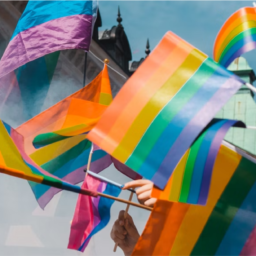
When I see or hear the words ‘racism’ and ‘racist’, I feel overcome with negative emotions. Depending on the context, there is often pain, sadness, anger, resentment, rejection, defiance, helplessness. I understand the desire for retaliation against racism and white supremacy, though I have also witnessed the pendulum swinging far in the other direction to extreme reverse racism and BIPOC inculpability.
I recently participated in a 6-week cohort that culminated in the host educator playing a hip-hop song replete with proud chants of the ‘N’ word, cheering the idea of making T-shirts stating ‘Fuck Whiteness.’ Oh boy. That is one of my many issues with a lot of the ‘anti-racism’ education out there. It’s actually reverse racist. It’s not unifying nor is it constructive. With cries to ‘defund the police’ and dismantle ‘oppressive capitalistic systems’, some attempts at anti-racism – while rightly grounded in much anger, rage and fury – often offer very little to provide cooperative, workable solutions.
On Racism and Anti-Racism
The word ‘racist’ apparently started replacing the word ‘prejudiced’ starting around 1970. It was defined as ‘prejudice, discrimination, or antagonism directed against someone of a different race based on the belief that one’s own race is superior.’ In the United States, targets of racism tend to be individuals of African, Hispanic, Asian, or Middle Eastern descent. As such, skin color is often a surrogate for targets of racism due to its ease of detectability.
In the wake of last year’s George Floyd protests, Merriam-Webster editors updated the definition of ‘racist’ in response to a reader’s request to more clearly include the role that racism plays in society.1 The definition now includes more explicit examples of social justice inequities embedded in laws and regulations within society and organizations.
I have come to realize that racism takes on several forms ranging from unintentional / unconscious all the way to intentional / blatant. With regard to unintentional / unconscious, a person may or may not even be aware that he or she is behaving in a way that is more favorable to one race over another. Harvard put together a series of fascinating online tests you can take to gauge your implicit preferences across a number of attributes, race (skin tone) being one of them.
If there is a silver lining to the global awareness of George Floyd’s killing, it is the wakeup call given to the world on the critical need for immediate wide-sweeping change – change within ourselves, our workplaces, our societies, our leaders, and our governing systems. It has been heartening to feel energy shifting toward the great white apology, to see corrective actions such retailers taking The 15% Pledge.
There is no question that we still have much work to do to rewire our psyches and our systems to abolish white supremacy. Becoming ever aware of the ways our thoughts, language, behavior, and policies have perpetuated white favorability is an important first step. Moving intentionally towards thoughts, language, behavior, and policies that are inclusive, harmonious, and unifying is an ideal second step. And continuously enacting thoughts, language, behavior, and policies that are inclusive, harmonious, and unifying for evermore would be the ideal ongoing solution.
The concept of anti-racism is understandable: it is defined as ‘the work of actively identifying and opposing racism.’ Upon contemplation, however, I have recently thought carefully about the words I am choosing to adopt and uphold on my inclusive journey, and I have chosen to strike ‘anti-racist’ from my vernacular. Why? Because I choose to be pro-unity, pro-diversity, pro-inclusivity, and pro-love. Taking a position of being anti or against something creates a sense of resistance and tension that I find aggravates my underlying positive intentions. By its presence, it begs for retaliation. To further illustrate, think of the war against drugs, the war against terror, the war against guns…by warring against the opposite, the opposite solidifies its stance, retaliates, and tension grows. It’s like the law of physics. Inevitably, we are just creating more wars.
Instead, I seek to be a peacemaker. I seek balance through compassion, cooperation, understanding, and partnership. I seek to listen, to welcome all humans into the fold, and give everyone a seat at the table. And that is my stance.
On Cultural Appropriation
I am admittedly a person who has borrowed from other cultures. I have Buddha statues all over my home, I wear evil eye and hamsa jewelry. I don kimono robes and native American feathers. Something inside me is drawn to the mystique of these different cultural symbols. My intentions are for appreciation however my actions could be viewed as appropriating and offensive. As the world draws ever closer, and as the blending of societies causes members of one race to take on the traditions, norms, and aspects of others, what is the yardstick by which anyone should measure appropriateness? After all, almost every culture offers tourism with ‘exit through the gift shop’ registers of clothing, jewelry, art, food and other native trinkets for sale to foreigners. Why are we so offended then when the customer dons these items or gains pleasure from reveling in the essence of these cultures? It’s a fine line, yet it is very specific, and it has everything to do with our history of pillaging and oppression.
In the United States, cultural appropriation almost always involves members of the dominant culture (or those who identify with it) ‘borrowing’ from the cultures of minority groups. Black people, Asians, Latinxs, and Native Americans generally tend to emerge as the targeted groups. When the dominant culture is rewarded for the heritage and labor of oppressed and marginalized communities, or when it disregards the origins and significance of what is being taken, or when it embraces the products of a culture while reinforcing and ignoring the prejudice experienced by the people who originated it, that’s when appropriation occurs.
Pictured: Cultural appropriation in the media Source: The Wrap
How to Not Appropriate
It’s sometimes difficult to identify cultural appropriation, because it is so deeply ingrained in our society. Whether it’s buying a new Halloween costume or watching tutorials on the new ‘it’ hairstyle, we can all do better to recognize why we’re buying or doing something associated with another culture. We can ask ourselves, ‘Why am I ‘borrowing’ this? Is it out of genuine interest? Is it something I feel called to, or does it simply look appealing and trendy? What is the source? For materials such as artwork, was it made by someone from a different culture? Did they give permission? Is this respectful to the culture? Am I using something sacred to another culture?
Questions here are our friends. Educating ourselves on cultural origin is a good start. If someone calls us out or complains about our donning or displaying, we must apologize sincerely, and not do it again.
The Effects of Racism
Black people have long suffered from persistent inequality in the United States due to centuries of racism, discrimination, and the web of white supremacy that has been sewn into the foundation of our nation. White supremacy and ideas purporting superiority of light-skinned races over others has perpetuated conditions that make it more difficult for Black Americans to get ahead in many aspects of life.
Health Care
When giving birth, Black women have more than a 300% higher mortality rate. Additionally, Black Americans are almost twice as likely to not have health insurance than their white counterparts. This results in Black Americans not being able to get proper care. A somber example of this is the current COVID-19 pandemic where 24,000 Black lives have been claimed.1 Factors such as these greatly contribute to the fact that Black Americans have a much shorter life expectancy in comparison to white Americans.
Education
In schools, Black students face disproportionate suspension rates. Black kids usually receive more severe punishments for the same behavior as their white peers. They are also nearly 6 times more likely to receive out-of-school suspensions.2 Graduation rates are lower for Black Americans, with the national high school graduation rate being 79.6% for Black students, 10 percentage points below the graduation rate for white students.3 Additionally, according to research, more white students graduate ‘on time’ in comparison to students of different races.
Justice
According to a study conducted by the University of Michigan, Rutgers University, and Washington University, Black men are 2.5 times more likely to be killed by police than white men, with bias also being documented in plea bargains and sentencing.4 While Black Americans are 5.1 times more likely than whites to be arrested, mass incarceration rates are showing a slow decline.5
Be a JEDI Knight
JEDI stands for Justice, Equality, Diversity and Inclusion. Embracing JEDI values requires us to examine our own biases and engage in critical thinking. I’ve compiled some action points to assist us in our JEDI journey:
- Learning: Let’s research and educate ourselves on the history and effects of racism and how it shapes our social, economic, and political landscape. Some great books and online resources include So You Want to Talk About Race by Ijeoma Oluo, The Business of Slavery and the Rise of American Capitalism by Calvin Schermerhorn, Stamped from the Beginning: The Definitive History of Racist Ideas in America by Ibram X. Kendi, and Racial Equity Tools.
- Participating: Let’s find events designed to combat racial injustice. Let’s volunteer for organizations that fight injustice. Let’s vote on inequality issues in our communities.
- Listening: Ah, the golden rule of listening is key. Let’s listen to what racial justice advocates have to say about racist behaviors and policies. Let’s remember that just because we may not have witnessed or experienced these things does not mean they don’t happen. Listening to these experiences can open our eyes to the different effects socially unjust policies may have on people.
- Discussing: Let’s talk to friends and family about the effects of racism. If we see racist behavior, we must call it out. Letting racist actions or words slide is not helping the cause. Additionally, posting support of anti-racism on social media is a great way to kickstart effective conversations about racial injustice.
The Human Beauty Movement’s Social Justice Action Plan
The founding principles of The Human Beauty Movement (The HBM) are based upon honoring all humans regardless of color, gender, age, creed, status, or ability, but I know that statements are not enough. The HBM will always stand for radical inclusivity, yet I know it must deliver against its words. In order to inspire all humans to recognize their own unique power and beauty and be the best versions of themselves, I want to ensure that all The HBM’s stakeholders – from our leadership teams, to our employees, to our partners, to our vendors, to our customers – feel valued, seen, and heard.
That’s why I have enrolled myself in Social Justice training, drafted this initial Social Justice Plan, and will seek the counsel of others on how I can become a better example of an inclusive leader. I want to ensure that The HBM has clear policies and practices in place that truly deliver on Justice, Equality, Diversity, and Inclusivity (JEDI) for all humans.
I invite you to be part of the journey. Hold me and my company accountable. We will always strive to do better and to be better when it comes to contributing to a kinder, more inclusive future for all.
You can learn more about The HBM’s values here.
References:
https://journals.sagepub.com/doi/full/10.1177/0963721418763931 [5]



















